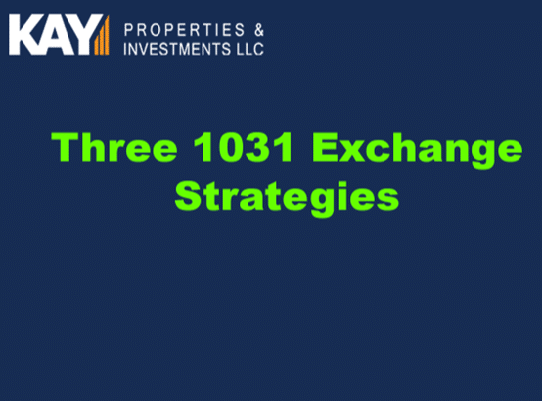By Betty Friant, Senior Vice President, Kay Properties & Investments
It’s both an exciting time and a very trying time when an investor sells a property and wants to defer taxes in a 1031 Exchange. A 1031 Exchange is when an investor sells a property that was held for business or investment use and then exchanges into another property of equal or greater value in an effort to defer taxes.
There are three basic choices that investors can make in 1031 Exchange investment opportunities.
Before reading on, make sure you visit the Kay Properties resource page and learn more about 1031 exchange basics so you invest like a professional.
1031 Exchange Investment Opportunity Number 1:
An investor can purchase a property that they own and manage on their own. This is what most investors think about and at first blush, seems like the easiest choice. However, when an investor tries to find a property, do their due diligence, and then close on the property within the timeframe of a 1031 Exchange, it’s often not as easy as it looks. If the purchase can be accomplished in time, the investor then has the burden of property management with the dreaded tenants, toilets, and trash that go along with management. Often, when purchasing a property to manage, investors find they must put all their money into one property which, to the investor’s detriment, negates any form of diversification*. The investor may even have to go to a bank to borrow funds to complete the purchase. Adding financing to a property adds potential recourse against the investors other assets, potential cash flow sweeps, and the potential to lose the property to the lender in foreclosure.
1031 Exchange Investment Opportunity Number 2:
Make sure you check out this super informative video by Chay Lapin, President of Kay Properties, as he describes some of the challenges of investing in NNN properties for a 1031 Exchange.
A second option is when the investor purchases a Triple Net Leased NNN property where the commercial tenant is responsible for rent, taxes, insurance, and some or all of the maintenance on the property. NNN Properties often are priced from $1.5 Million to over $10 Million so it may be hard to diversify and investors could end up being over concentrated in one asset class, with one tenant, and one location. During the Covid 19 crisis, many tenants asked for rent relief including even Starbucks, an investment grade tenant. This means NNN owners might have to hire an attorney to negotiate with a massive company over terms and payments which would be tricky for most 1031 investors to say the least. There are also other management issues that many owners don’t think about such as making sure insurance is up to date, that any common area maintenance fees are prorated and collected, that the tenant is indeed paying property taxes in a timely manner and how to re-tenant the building if the property becomes vacant. If there is a loan on the property, the monthly mortgage payment has to be made by the owner even if there is no tenant paying rent. It can get burdensome and be incredibly more risky than 1031 exchangers are often led to believe.
Make sure you view this great video by Dwight Kay, Founder and CEO of Kay Properties describing how Delaware Statutory Trusts can be used for a 1031 exchange.
1031 Exchange Investment Opportunity Number 3:
Another way to invest in a 1031 Exchange is into DST 1031 Properties. The DST Delaware Statutory Trust property is where the investors own a piece of the property instead of owning the whole property. By dividing up their investment funds into multiple properties, an investor can own properties in different geographic locations, with different asset classes and different tenants and even different property managers. With a DST, investors are usually investing in high quality properties that they might not be able to afford on their own. These properties are professionally managed and so they are passive investments where the DST sponsor companies (the asset managers) are the ones responsible with all the day to day issues involving real estate ownership. Tenants, toilets, and trash are no longer a concern for the investors. If the 1031 investor needs to replace debt in their 1031 Exchange, the loans in the DSTs are non-recourse to the investors which means that the investor doesn’t have to sign personally for the loans. For those investors not wanting the risk of lender foreclosure and not needing debt replacement in their 1031 exchange, due to the fact that they already paid off their mortgages and own their property free and clear, debt free DSTs are available with no long-term mortgages encumbering the assets. DSTs feature properties in most of the major asset classes including multi-family, medical office, NNN retail, industrial, and even self-storage.

